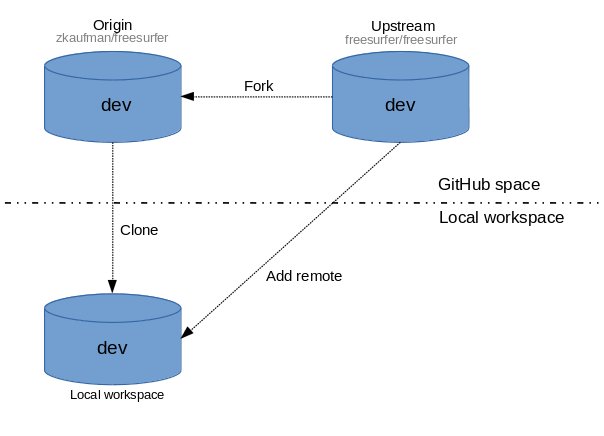This page is targeted at users who wish to contribute changes to the Freesurfer code base. Members of the public who simply want to clone the repo and build on their home machine, but dont plan on contributing changes, should consult the read-only git repo. Lastly, users who just want access to the code can clone directly from the official Freesurfer github page:
Initial Setup
The first thing users at the Martinos Center need to do is prepend the directory /usr/pubsw/packages/git-annex/current/bin to their PATH so that the proper version of git is beeing used.
The initial setup for contributing to the Freesurfer repository involves the user forking off the Freesurfer GitHub repo, cloning the users fork into a local repository, then adding the Freesurfer repository as an upstream remote. This setup is illustrated below, followed by a more detailed description of the steps involved:

Sign up for a github account if you don't already have one. When creating an account, you can use any email you want, but developers at the Martinos Center should eventually link their <username>@mgh.harvard.edu email to their GitHub account. This can be done after the account is created.
From your GitHub account, fork the Freesurfer project repository by clicking on the 'Fork' button near the top right-hand of the page. This creates a copy of the Freesurfer code base under your account on the GitHub server.

- On your local machine, make a clone of your Freesurfer repository (the one you forked):
git clone git@github.com:<git_username>/freesurfer.git
Add the main Freesurfer repository as a remote to the local clone you already have on your local disk, and set it as the upstream remote:
git remote add upstream git@github.com:freesurfer/freesurfer.git
- Type the following command to make sure you have the proper setup:
git remote -v origin git@github.com:zkaufman/freesurfer.git (fetch) origin git@github.com:zkaufman/freesurfer.git (push) upstream git@github.com:freesurfer/freesurfer.git (fetch) upstream git@github.com:freesurfer/freesurfer.git (push)
Note: If you are seeing an "X11 forwarding request failed" warning when communicating with github, this is caused by a global ssh setting in /etc/ssh/ssh_config. To prevent these forwarding requests to github servers, add the following lines to your ~/.ssh/config
Host *github.com ForwardX11 no
Committing Changes
To contribute the the Freesurfer code base, users should 1) Update their code 2) Create a new branch off the dev branch 3) Commit the changes and push the branch to their fork (origin) 4) Submit a Pull Request into freesurfer/dev to get those changes into the Freesurfer code base. This workflow is illustrated below, followed by a more detailed description of the steps involved:
- When you start to make changes, the first thing to do is make sure you are in the dev branch and everything is up to date with the upstream repo:
git branch * dev
git pull upstream dev
Then create a new branch (off dev) to hold your work and start making changes. Ideally, use a prefix signaling the purpose of the branch:
git checkout -b nf-my-feature
nf- for new features
bf- for bug fixes
rf- for refactoring
doc- for documentations contributions.
test- for test related contributions.
Work on this copy on your computer using Git to do the version control. When you're done editing, commit the files to the local branch and push the branch to origin (your personal GitHub account):
git add <modified_files> git commit -m "Commit message" git push origin nf-my-feature
Finally, go to the GitHub web page of your fork of the Freesurfer repo, and click Pull request to send your changes to the maintainers for review. Make sure you are submitting your newly created branch into the freesurfer/dev. This will send an email to the committers. You can commit new changes to this branch and keep pushing to your remote -- github automagically adds them to your previously opened Pull request.

Once you have submitted your pull request for the nf-my-feature, it is best practice to switch back into dev and do an update. You are then free to start the process anew (i.e. create a new branch, commit changes, submit pull request):
git checkout dev git pull upstream dev
Cleanup steps (Optional)
- Once your pull request is accepted (you should get an email), feel free to delete the branch you created:
git branch -D nf-my-feature
Developing
Instructions on how to further work with the Freesurfer source code, including building, testing, and adding a binary to the tree, should consult the Freesurfer Developers Guide:
Data files
A default clone of the repo will only give the user source code. Data files are stored in git annex, exist as broken symlinks by default, and need to be specially requested. To request a datafile, first add the remote repository that stores all the Freesurfer data files (you only need to this once):
(Users outside the Center) git remote add datasrc https://surfer.nmr.mgh.harvard.edu/pub/dist/freesurfer/repo/annex.git git fetch datasrc (Users within the Center) git remote add datasrc file:///space/freesurfer/repo/annex.git git fetch datasrc
Your list of remote repositories should now look something like this:
git remote -v datasrc https://surfer.nmr.mgh.harvard.edu/pub/dist/freesurfer/repo/annex.git (fetch) datasrc https://surfer.nmr.mgh.harvard.edu/pub/dist/freesurfer/repo/annex.git (push) origin git@github.com:zkaufman/freesurfer.git (fetch) origin git@github.com:zkaufman/freesurfer.git (push) upstream git@github.com:freesurfer/freesurfer.git (fetch) upstream git@github.com:freesurfer/freesurfer.git (push)
Now you can just specifically request whatever datafile you need:
git annex get GEMS2/Testing/test.txt.gz ######################################################################## 100.0% (checksum...) ok (recording state in git...)
Or just get everything (Not recommended):
git annex get .
For more information on how to work with the data files and git annex in general, see the following page:
FAQ
Q: The github.com page for my fork of freesurfer/freesurfer says "This branch is 3 commits behind freesurfer:dev". How do I update my fork?
A: A fork will always trail the upstream, so it's very common to be behind in commits, but to update your fork, assuming you have cloned it on your local machine, and have confirmed through git remote -v that your upstream is correct (per instructions above), then do this:
git checkout dev git fetch upstream git merge upstream/dev git push origin
